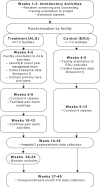Addressing methodological challenges in implementing the nursing home pain management algorithm randomized controlled trial
- PMID: 22879574
- PMCID: PMC4426859
- DOI: 10.1177/1740774512454243
Addressing methodological challenges in implementing the nursing home pain management algorithm randomized controlled trial
Abstract
Background: Unrelieved pain among nursing home (NH) residents is a well-documented problem. Attempts have been made to enhance pain management for older adults, including those in NHs. Several evidence-based clinical guidelines have been published to assist providers in assessing and managing acute and chronic pain in older adults. Despite the proliferation and dissemination of these practice guidelines, research has shown that intensive systems-level implementation strategies are necessary to change clinical practice and patient outcomes within a health-care setting. One promising approach is the embedding of guidelines into explicit protocols and algorithms to enhance decision making.
Purpose: The goal of the article is to describe several issues that arose in the design and conduct of a study that compared the effectiveness of pain management algorithms coupled with a comprehensive adoption program versus the effectiveness of education alone in improving evidence-based pain assessment and management practices, decreasing pain and depressive symptoms, and enhancing mobility among NH residents.
Methods: The study used a cluster-randomized controlled trial (RCT) design in which the individual NH was the unit of randomization. The Roger's Diffusion of Innovations theory provided the framework for the intervention. Outcome measures were surrogate-reported usual pain, self-reported usual and worst pain, and self-reported pain-related interference with activities, depression, and mobility.
Results: The final sample consisted of 485 NH residents from 27 NHs. The investigators were able to use a staggered enrollment strategy to recruit and retain facilities. The adaptive randomization procedures were successful in balancing intervention and control sites on key NH characteristics. Several strategies were successfully implemented to enhance the adoption of the algorithm. LIMITATIONS/LESSONS: The investigators encountered several methodological challenges that were inherent to both the design and implementation of the study. The most problematic issue concerned the measurement of outcomes in persons with moderate to severe cognitive impairment. It was difficult to identify valid, reliable, and sensitive outcome measures that could be applied to all NH residents regardless of the ability to self-report. Another challenge was the inability to incorporate advances in implementation science into the ongoing study
Conclusions: Methodological challenges are inevitable in the conduct of an RCT. The need to optimize internal validity by adhering to the study protocol is compromised by the emergent logistical issues that arise during the course of the study.
Trial registration: ClinicalTrials.gov NCT01399567.
Figures
Similar articles
-
The future of Cochrane Neonatal.Early Hum Dev. 2020 Nov;150:105191. doi: 10.1016/j.earlhumdev.2020.105191. Epub 2020 Sep 12. Early Hum Dev. 2020. PMID: 33036834
-
Pain Management Algorithms for Implementing Best Practices in Nursing Homes: Results of a Randomized Controlled Trial.J Am Med Dir Assoc. 2016 Apr 1;17(4):348-56. doi: 10.1016/j.jamda.2016.01.001. Epub 2016 Feb 17. J Am Med Dir Assoc. 2016. PMID: 26897592 Free PMC article. Clinical Trial.
-
COSMOS--improving the quality of life in nursing home patients: protocol for an effectiveness-implementation cluster randomized clinical hybrid trial.Implement Sci. 2015 Sep 15;10:131. doi: 10.1186/s13012-015-0310-5. Implement Sci. 2015. PMID: 26374231 Free PMC article. Clinical Trial.
-
Telephone interventions for symptom management in adults with cancer.Cochrane Database Syst Rev. 2020 Jun 2;6(6):CD007568. doi: 10.1002/14651858.CD007568.pub2. Cochrane Database Syst Rev. 2020. PMID: 32483832 Free PMC article.
-
Systematic Review of Randomized Controlled Trials in Australian Nursing Homes from 2000 to 2018.J Am Geriatr Soc. 2021 Apr;69(4):1086-1093. doi: 10.1111/jgs.16944. Epub 2020 Nov 20. J Am Geriatr Soc. 2021. PMID: 33216941
Cited by
-
Geriatric palliative care in long-term care settings with a focus on nursing homes.J Palliat Med. 2013 Oct;16(10):1180-7. doi: 10.1089/jpm.2013.9474. Epub 2013 Aug 28. J Palliat Med. 2013. PMID: 23984636 Free PMC article.
-
Algorithm-based pain management for people with dementia in nursing homes.Cochrane Database Syst Rev. 2022 Apr 1;4(4):CD013339. doi: 10.1002/14651858.CD013339.pub2. Cochrane Database Syst Rev. 2022. PMID: 35363380 Free PMC article.
-
The Method of Randomization for Cluster-Randomized Trials: Challenges of Including Patients with Multiple Chronic Conditions.Int J Stat Med Res. 2016 Jan 8;5(1):2-7. doi: 10.6000/1929-6029.2016.05.01.1. Int J Stat Med Res. 2016. PMID: 27478520 Free PMC article.
-
Methodological challenges in conducting instrumentation research in non-communicative palliative care patients.Appl Nurs Res. 2020 Feb;51:151199. doi: 10.1016/j.apnr.2019.151199. Epub 2019 Nov 6. Appl Nurs Res. 2020. PMID: 31759841 Free PMC article.
-
A mixed-methods approach to investigating the adoption of evidence-based pain practices in nursing homes.J Gerontol Nurs. 2014 Jul;40(7):52-60. doi: 10.3928/00989134-20140311-01. Epub 2014 Mar 18. J Gerontol Nurs. 2014. PMID: 24640959 Free PMC article.
References
-
- Lapane KL, Quilliam BJ, Chow W, et al. The association between pain and measures of well-being among nursing home residents. J Am Med Dir Assoc. 2012;13:344–49. - PubMed
-
- Sengupta M, Bercovitz A, Harris-Kojetin LD. Prevalence and management of pain, by race and dementia among nursing home residents: United States 2004. NCHS Data Brief. 2010;30:1–8. - PubMed
-
- AGS Panel on Persistent Pain in Older Persons The management of persistent pain in older persons. J Am Geriatr Soc. 2002;50:S205–S224. - PubMed
-
- Won A, Lapane K, Gambassi G, et al. Correlates and management of nonmalignant pain in the nursing home. SAGE Study Group. Systematic Assessment of Geriatric Drug Use via Epidemiology. J Am Geriatr Soc. 1999;47:936–42. - PubMed
Publication types
MeSH terms
Associated data
Grants and funding
LinkOut - more resources
Full Text Sources
Medical



